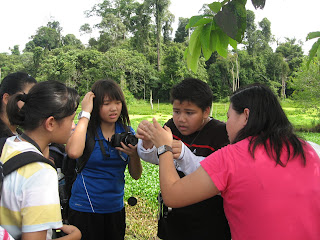


The second CABEP field trip to Samarakan took place on the 16-17 April with 11 students and 2 teachers from SM Kai Dee and 9 students & 4 teachers from SMK Bandar, as well as four representatives from CIMB led by Encik Suaidi. As it was polling day of the 10th Sarawak State Election, we delayed the start of our journey to 9.30am to allow voting before the trip.
The participants from SM KaiDee were Form two students while those from SMK Bandar were Form four’s. After an introductory lecture, Joannes Unggang told the students and teachers about the conservation program of the Sarawak Planted Forest. Alex Jukie gave a lively talk about Wildlife Conservation, Ollince Tateh taught the students about Odonata while Belden introduced Birds and taught on birdwatching and taking notes of observations. The workshop session on how to use cameras was conducted by Joannes at the end of the lectures.
After a short rest in the evening and a quick dinner, everyone was ready for the night jungle trek. The students were divided into 4 groups, each group having a camera to record their sightings during the trek.
The moon was almost full that evening and was shining bright. Frogs, spiders, stick insects, lizards, ants, snails, civet cats etc were spotted during the trek.
The KaiDee group was up and ready to start birdwatching early the next morning well before the appointed time of 7am when the other groups arrived at the meeting point. Binoculars were issued to each of the participants after a brief instruction was given on their proper use and care. Herons, kingfishers, cuckoos, egrets, parakeets, swallows, starlings, sandpipers, waterhens were spotted and some students were able to note detailed enough observations to help in identifying the bird species from field guides, with the help of Belden and Ngegang.
Everyone was hungry after the morning session of birdwatching and tucked into breakfast. During breakfast while waiting for the food, Alex told the students about the Wildlife Protection Act and why it is important that wildlife should not be kept as pets or be traded.
Rejuvenated after breakfast, the students went on to study Odonata in the field and learnt to identify dragonflies from damselflies, males and females etc with Ollince to guide them.
After morning tea, it was time for the students to get to work on their own presentation of what they have learnt about conservation and biodiversity and their plans on outreaching to others in the community. Mr. Tham Chee Keong gave a short lecture on Forestry As A Career just before lunch.
During their presentations, the students showed the photographs that they had taken, and some groups presented the observations that they have made, which delighted Alex who remarked that they have taken an important step into the discipline of careful observation and note taking which is the essence of scientific field work.
The bus was ready by the time the students finished their presentation and everyone was brought safely back to Bintulu by 5pm on Sunday.



